Ergonomics
Solutions to Control Hazards
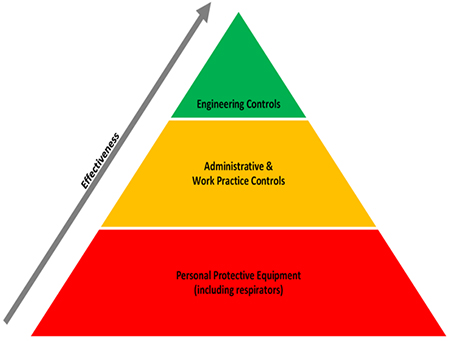
Ergonomics pyramid - Showing Engineering Controls at the top, Administrative and Work Practice Controls in the middle, and Personal Protective Equipment (including respirators) at the base. An arrow is going from bottom to top, along the side of the pyramid, labeled Effectiveness.
Many industries have successfully implemented ergonomic solutions in their facilities as a way to address their workers' MSD injury risks. These interventions have included modifying existing equipment, making changes in work practices and purchasing new tools or other devices to assist in the production process. Making these changes has reduced physical demands, eliminated unnecessary movements, lowered injury rates and their associated workers' compensation costs, and reduced employee turnover. In many cases, work efficiency and productivity have increased as well. Simple, low-cost solutions are often available to solve problems. Use the information on this page to see what has worked for others in your industry or in other industries.
Overview of Controls for MSD Hazards
To reduce the chance of injury, work tasks should be designed to limit exposure to ergonomic risk factors. Engineering controls are the most desirable, where possible. Administrative or work practice controls may be appropriate in some cases where engineering controls cannot be implemented or when different procedures are needed after implementation of the new engineering controls. Personal protection solutions have only limited effectiveness when dealing with ergonomic hazards.
| Type of Control | Workplace Examples |
|---|---|
| Engineering Controls (implement physical change to the workplace, which eliminates/reduces the hazard on the job/task) |
|
| Administrative and Work Practice Controls (establish efficient processes or procedures) |
|
| Personal Protective Equipment (use protection to reduce exposure to ergonomics-related risk factors) |
|
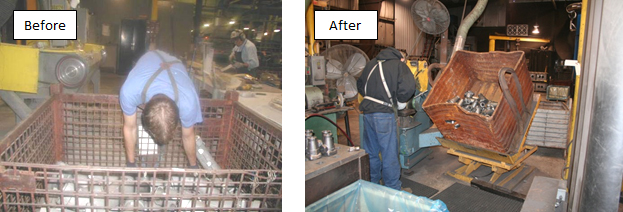
Source: Solutions for the Prevention of Musculoskeletal Injuries in Foundries, OSHA Publication 3465, (2012)
Success Stories
- Success Stories. OSHA collects brief stories from employers that have implemented ergonomics programs or used best practices with successful results. The success stories are grouped by SIC codes.
- Case Studies. OSHA collects accounts from employers that have implemented measures, programs or effective practices that have helped reduce the risk of ergonomic injuries or other positive outcomes.
- Private Sector Ergonomics Programs Yield Positive Results (PDF). U.S. General Accounting Office (GAO) Report HEHS-97-163. (August 1997). This report to Congress prepared by the Government Accounting Office looks at the efforts and successes of 5 companies who dealt with their ergonomic issues. The companies are: American Express, AMP
Resources
General
- Ergonomics and Musculoskeletal Disorders. National Institute for Occupational Safety and Health (NIOSH) Workplace Safety and Health Topics. Includes a variety of links with information about risk factors and solutions that help protect workers.
Guidelines
These guidelines contain recommendations, best practices and lessons learned. They are designed to help employers and workers recognize and control industry-specific ergonomics-related risk factors.
- Solutions for the Prevention of Musculoskeletal Injuries in Foundries. OSHA Publication 3465, (2012). Provides recommendations for foundries to help increase employer and worker awareness of ergonomics-related risk factors, alleviate muscle fatigue, increase productivity and reduce the number and severity of work-related MSDs.
- Guidelines for Nursing Homes: Ergonomics for the Prevention of Musculoskeletal Disorders. Provides recommendations for nursing home employers to help reduce the number and severity of work-related MSDs in their facilities.
- Guidelines for Shipyards: Ergonomics for the Prevention of Musculoskeletal Disorders. OSHA Publication 3341, (2008). Provides recommendations for shipyards to help reduce the number and severity of work-related MSDs, increase employer and employee awareness of ergonomic risk factors, eliminate unsafe work practices, alleviate muscle fatigue, and increase productivity.
- Ergonomic Guidelines for Manual Material Handling (PDF). DHHS (NIOSH) Publication 2007-131, (April 2007). Recognize high-risk MMH work tasks and choose effective options for reducing their physical demands.
- Prevention of Musculoskeletal Injuries in Poultry Processing (EPUB | MOBI). OSHA Publication 3213, (2004, Revised 2013). Also available in Spanish (EPUB | MOBI).
- Guidelines for Retail Grocery Stores: Ergonomics for the Prevention of Musculoskeletal Disorders. OSHA Publication 3192, (2004). Presents recommendations for changing equipment, workstation design, or work methods with the goal of reducing work-related MSDs.
- Ergonomic & Safety Assessment Guide for Machines and Equipment. National Safety Council. (2007). Comprehensive checklist based on ANSI B11.TR1-1993. Includes considerations for machine operation, installation and maintenance.
- A Guide to Selecting Non-Powered Hand Tools (PDF). DHHS (NIOSH) Publication 2004-164, (2004). Presents an easy- to- use guideline for selecting or purchasing the best available ergonomically designed non-powered hand tools.
- Elements of Ergonomics Programs: A Primer Based on Workplace Evaluations of Musculoskeletal Disorders (PDF). DHHS (NIOSH) Publication 97-117, (March 1997). Describes the basic elements of a workplace ergonomics program aimed at preventing work-related musculoskeletal disorders. Includes a "toolbox," which is a collection of techniques, methods, reference materials and sources for other information that can help in program development.
- Voluntary Ergonomics Guideline for the Furniture Manufacturing Industry. American Furniture Manufacturers Association (AFMA) Publication (2003). Assists employers and employees in recognizing and controlling potential ergonomic hazards.
- Control Back-pain Risks from Whole-body Vibration. Health and Safety Executive (HSE), United Kingdom, (2005). For operators of off-road mobile machinery, agricultural vehicles or industrial trucks to help manage the risk of back pain.
- Hand-arm Vibration at Work. Health and Safety Executive (HSE), United Kingdom, (2005). Advice for employers on regular and frequent use of hand-held power tools, hand-guided powered equipment, and powered machines which process hand-held materials.
Industry or Task-Specific Solutions
Agriculture
- Simple Solutions: Ergonomics for Farm Workers (PDF). DHHS (NIOSH) Publication 2001-111, (February 2001). Describes how to make or order inexpensive new tools or to modify existing ones to reduce the risk of backaches and pains in the arms, shoulders and hands of farm workers. Also available in Spanish (PDF).
- Conference Proceedings: Prevention of Musculoskeletal Disorders for Children and Adolescents Working in Agriculture (PDF). DHHS (NIOSH) Publication 2004-119, (June 2004). Provides a summary of a national conference that was held in Cincinnati, Ohio, May 6-7, 2002. The agricultural safety and health experts who attended the meeting discussed research needs regarding prevention of MSDs for children and adolescents working in agriculture.
Apparel and Footwear
- An Ergonomic Handbook for the Clothing Industry. Union of Needletrades, Industrial and Textile Employees, the Institute for Work & Health, and the Occupational Health Clinics for Ontario Workers, Inc, (2001). Focuses on common ergonomic problems and solutions identified in clothing manufacturing plants to prevent injuries.
Baggage Handling
- Baggage Handling (Airline industry) eTool. OSHA. Describes many of the common ergonomic hazards associated with the baggage handling process as well as providing possible solutions that are ranked according to their feasibility to the operations.
- Ergonomic Solutions: Baggage Handling (Spanish). Texas Department of Insurance (TDI), Division of Workers' Compensation, (October 2005). Provides a PDF version of OSHA's baggage handling e-Tool in English and in Spanish.
Beverage Delivery
- Beverage Delivery eTool. OSHA. Describes ergonomic hazards and possible solutions for workers in the beverage delivery Industry.
- Ergonomic Interventions for the Soft Drink Beverage Delivery Industry (PDF). DHHS (NIOSH) Publication 96-109, (July 1996). Presents the results of an ergonomic study to investigate, identify and reduce risk factors that may cause MSDs and injury in the soft drink beverage delivery industry.
- Beverage Distribution Hazard Alert Letter. OSHA, (August 18, 2011).
Carpet Laying
- NIOSH Alert: Preventing Knee Injuries and Disorders in Carpet Layers. DHHS (NIOSH) Publication 90-104, (May 1990). Includes research and recommendations to help prevent knee injury.
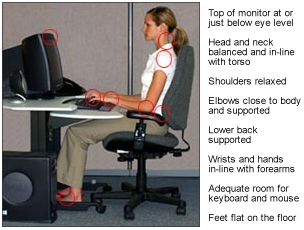
Source: OSHA Computer Workstations eTool
Computer Workstation
- Computer Workstations eTool. OSHA. Illustrates simple, inexpensive principles that will help create a safe and comfortable computer workstation. Discusses basic design goals to consider when setting up a computer workstation or performing computer-related tasks.
- Easy Ergonomics for Desktop Computer Users. Cal/OSHA, (October 2018). Provides suggestions for working safely and reducing risks of injury while working at a desktop computer.
- Workstation Adjustments for Comfort and Safety. Texas Department of Insurance (TDI), Division of Workers' Compensation, (October 2005). Provides recommendations to create a more comfortable, more efficient, healthier and safer workstation environment.
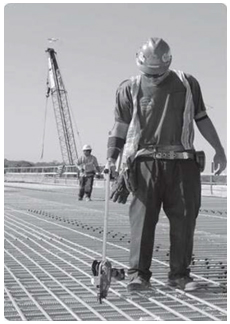
Source: Alliance Program Construction Roundtable, 2010
Construction
- Ergonomics eTool: Solutions for Electrical Contractors. OSHA. Describes common hazards that electrical contractors may encounter and possible solutions for these hazards.
- Prevention Videos (v-Tools): Construction Hazards. OSHA. The following videos show worksite sprains and strains in construction and corrective actions.
- Pulling Cables (available in English and Spanish)
- Laying Stone (available in English and Spanish)
- Simple Solutions: Ergonomics for Construction Workers (PDF). DHHS (NIOSH) Publication 2007-122, (October 2006). Provides practical ideas to help reduce the risk of repetitive stress injury in common construction tasks. Also available in Spanish (PDF).
- Welding – Ergonomics Fact Sheet. Canadian Centre for Occupational Health and Safety. Guidance provided by the Canadian government concerning ergonomics for welders.
- Prevention of Strains, Sprains and Material Handling Injuries in Construction (PPSX). Alliance Program Construction Roundtable, (June 2010). Participants developed a slide presentation on the prevention of strains, sprains and material handling injuries in construction.
- Strains, Sprains and Material Handling Safety Tips for Employers and Workers. Alliance Program Construction Roundtable. Participants developed safety tips sheets for employers and workers focusing on the reduction of strains and sprains in the construction industry.
- Sprains and Strains Prevention Toolbox Safety Talk. Alliance Program Construction Roundtable, (May 2010). Participants developed a toolbox talk on the prevention of sprains and strains in construction.
Food Distribution Centers
- A Best Practice Guide for the Reduction of Musculoskeletal Disorders in Food Distribution Centers. Institute for Ergonomics, the Ohio State University, (2005). Provides guidance to distribution centers for the development of a process to address the hazards associated with the food distribution process and identify engineering and administrative controls.
Foundries
- Solutions for the Prevention of Musculoskeletal Injuries in Foundries. OSHA Publication 3465, (2012). Provides recommendations for foundries to help increase employer and worker awareness of ergonomics-related risk factors, alleviate muscle fatigue, increase productivity and reduce the number and severity of work-related MSDs.
Furniture Manufacturing
- Voluntary Ergonomics Guideline for the Furniture Manufacturing Industry. American Furniture Manufacturers Association (AFMA) Publication, (2003). Assists employers and employees in recognizing and controlling potential ergonomic hazards.
Grocery Stores and Warehousing
- Guidelines for Retail Grocery Stores: Ergonomics for the Prevention of Musculoskeletal Disorders. OSHA Publication 3192, (2004). Presents recommendations for changing equipment, workstation design, or work methods with the goal of reducing work-related MSDs.
- Grocery Warehousing Ergonomics eTool. OSHA. Describes example ergonomic hazards and solutions with an emphasis on traditional order picking, which accounts for a large number of MSDs. Other areas addressed are transport, storage, packaging and work practice.
- Grocery Warehouse Implements Program to Control MSDs. OSHA Regional News Release BOS 2015-154, (August 19, 2015).
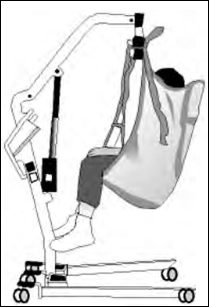
Source: Guidelines for Nursing Homes: Ergonomics for the Prevention of Musculoskeletal Disorders. OSHA Publication 3182, (2009).
Healthcare
- Practice Principles for Work-related Musculoskeletal Disorder (January 24, 2023), American Institute of Ultrasound in Medicine (AIUM). Journal of Ultrasound in Medicine, 42(5), 1139-1157.
- Industry Standards for the Prevention of Work-Related Musculoskeletal Disorders in Sonography (2021), Society of Diagnostic Medical Sonography (SDMS). A product of a 2016 Consensus Conference on Work Related Musculoskeletal Disorders involving 26 sonography-related professional organizations, accreditation bodies, and manufacturers.
- Nursing Home Improves Resident Lifting/Handling Program to Protect Workers From Serious Injury. OSHA Regional News Release, (August 5, 2015).
- Safe Patient Handling: Preventing Musculoskeletal Disorders in Nursing Homes. OSHA Publication 3708, (February 2014).
- Guidelines for Nursing Homes: Ergonomics for the Prevention of Musculoskeletal Disorders. OSHA Publication 3182, (2003, Revised 2009). Provides recommendations for nursing home employers to help reduce the number and severity of work-related MSDs in their facilities.
- OSHA Ergonomic eTools are stand-alone, interactive, web-based training designed to help prevent MSDs in health care.
- Hospitals eTool: Ergonomics. Focuses on some of the hazards and controls found in the hospital setting, and describes standard requirements as well as recommended safe work practices for employee safety and health.
- Hospitals eTool: Sonography. Addresses ergonomics-related risk factors for sonographers.
- Beyond Getting Started: A Resource Guide for Implementing a Safe Patient Handling Program in the Acute Care Setting. Association of Occupational Health Professionals in Healthcare (AOHP), (Revised Summer 2011). Provides tools for the occupational health professional to implement a safe patient handling program.
- Patient Handling and Movement Assessments: A White Paper. Facility Guidelines Institute, (April 2010). Goals of the white paper include providing readers with information and resources to help them prepare a patient handling and movement assessment and establish a business case for implementing a patient handling and movement program.
- A Back Injury Prevention Guide in the Health Care Industry for Health Care Providers. Cal/OSHA, (Revised November 1997). Provides general guidance for employers and workers about preventing back injury as a result of lifting and moving patients and residents.
- Safe Lifting and Movement of Nursing Home Residents. DHHS (NIOSH) Publication 2006-117, (February 2006). This guide is intended for nursing home owners, administrators, nurse managers, safety and health professionals and workers who are interested in establishing a safe resident handling program. Also available in Spanish.
- Safe Patient Handling and Mobility. U.S. Department of Veterans Affairs. Provides information about the proper techniques for patient transfers and lifting as well as ways to evaluate the workplace and develop an effective injury-prevention program.
- Association of Safe Patient Handling Professionals (ASPHP). The ASPHP Learning Center wants to provide you with helpful information that will assist you in planning and instituting the daily practice of safe patient handling. Contains useful resource links, case studies, publications, tools and tips and legislative updates.
Manufacturing
- Controlling the Ergonomic Hazards of Wiring Tasks for Household Appliances. DHHS (NIOSH) Publication 98-108, (1998). Presents a hierarchy of four methods for reducing workers' risk factors for MSDs.
Meatpacking
- Ergonomics Program Management Guidelines for Meatpacking Plants. OSHA Publication 3123, (1993). Provides information on the steps employers should take to determine if they have ergonomic-related problems in their workplaces, to identify the nature and location of those problems and to implement measures to reduce or eliminate them.
- Participatory Ergonomic Interventions in Meatpacking Plants (PDF). DHHS (NIOSH) Publication 94-124, (1994). Provides in-depth reports of intervention projects to reduce ergonomic hazards at three meat packing plants.
Mining
- Ergonomics in Mining: Charting a Path to a Safer Workplace (PDF). DHHS (NIOSH) Publication 2006-141, (September 2006). Provides information on ergonomic processes which can be implemented in a setting such as mining where working conditions frequently change and workers are periodically exposed to extreme weather conditions.
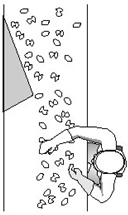
Source: Prevention of Musculoskeletal Injuries in Poultry Processing. OSHA Publication 3213, (Revised 2013)
Poultry Processing
- Poultry Industry Letter from OSHA and the Food Safety Inspection Service (FSIS). (August 1, 2014).
- Poultry Processing Letter – Medical Management. OSHA, (August 4, 2015).
- Prevention of Musculoskeletal Injuries in Poultry Processing (EPUB | MOBI). OSHA Publication 3213, (2004, Revised 2013). Also available in Spanish (EPUB | MOBI).
- Poultry Processing Industry eTool. OSHA. Focuses on identifying and controlling major hazards that contributed to the high rates of injuries found in an OSHA Survey of the poultry processing industry.
- Musculoskeletal Disorders and Traumatic Injuries Among Employees at a Poultry Processing Plant. NIOSH Health Hazard Evaluation (HHE) Report 2012-0125-3204. (March 2014). Interim report provides recommendations for poultry processing to reduce MSDs.
Printing
- Printing Industry eTool. OSHA. Provides information about ergonomics in the printing industry based on the experience of others to help make the process of hazard minimization easier. A description of the printing process and the trouble areas that have currently been identified are detailed for each major style of printing: lithography, flexography and screen printing.
Sewing
- Sewing and Related Procedures eTool. OSHA. Workers involved in sewing activities, such as manufacturing garments, shoes and airplane or car upholstery, may be at risk of developing MSDs. This eTool provides example ergonomics solutions specific to sewing. Also available in Spanish.
Shipyards
- Guidelines for Shipyards: Ergonomics for the Prevention of Musculoskeletal Disorders. OSHA Publication 3341, (2008). Provides recommendations for shipyards to help reduce the number and severity of work-related MSDs, increase employer and employee awareness of ergonomic risk factors, eliminate unsafe work practices, alleviate muscle fatigue, and increase productivity.
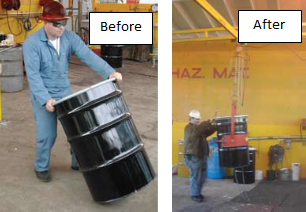
Source: Guidelines for Shipyards: Ergonomics for the Prevention of Musculoskeletal Disorders. OSHA Publication 3341, (2008).
Veterinary
- Introduction to Ergonomics Guidelines for Veterinary Practice. American Veterinary Medical Association (AVMA). Provides information about the issues veterinarians face when dealing with ergonomics.

